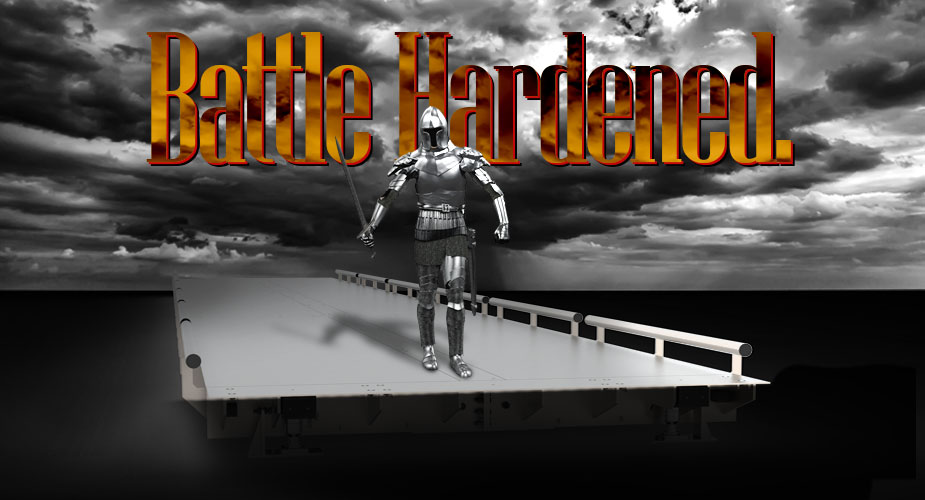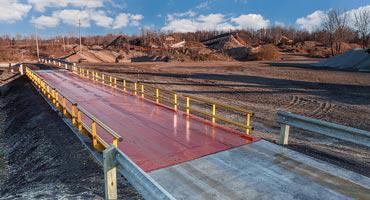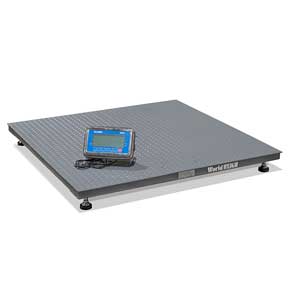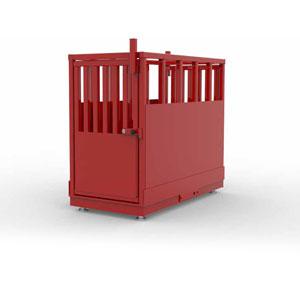The B-TEK Learning Center
Resources to help you scale your business with B-TEK.

In this article, we are going to explore whether it's worthwhile to pay a premium to galvanize your truck scale.
Have you noticed that most outdoor light posts, highway guard rails, and other items made from rolled sheet metal have the same gray color with a distinctive pattern? Do you know why? Most people don't pay attention to this but if you're familiar with the steel industry you know that preparation, coatings, and paint systems are the most important factors to prevent rusting and prolonging the life of steel.
The reason for this gray color and pattern (referred to as spangle) is that these metal products have been through the galvanizing process. galvanized. Generally, any metal made to be outside, in the elements, is commonly given a protective zinc coating using a process called galvanization. Did you know that galvanizing has been around for over 200 years? It is still used because it flat out works, But is it worth the extra cost?
What is Galvanizing?
First, let us learn a little about what galvanizing is. The hot dip galvanizing process is the most common method of creating galvanized metal, so we will focus on this method. This is the process of immersing raw steel into a liquid zinc “bath". The zinc-iron alloy that is created during this process is more resistant to corrosion than untreated steel. In general, there are nine steps to hot-dip galvanizing.

Pre-Galvanizing Cleaning
The first five steps in the galvanizing process are surface preparation steps. The goal is to clean the base metal, also referred to as the substrate, to ensure good bonding when it is dipped in the bath of molten zinc.
1. Degreasing: This step is designed to remove dirt and oily substances from the surface of the metal.
2. Rinsing: A step to remove the degreasing agent.
3. Pickling: This step removes scale and iron oxides on the surface of the metal so the raw steel will be fully exposed to the molten zinc.
4. Rinsing: A step to remove the pickling acid.
5. Flux solution: This final step in surface preparation removes any remaining oxides and adds a protective layer to prevent further oxidation before the zinc dip.
Galvanizing
The next two steps take the untreated steel and form a galvanized coating.
1. Drying: This step is required to make sure the coating of zinc can firmly adhere to the steel.
2. Zinc Bath: This is the step where the steel is dipped into molten zinc. In general, this bath is made of pure zinc, but other metals can be added if desired. For example, aluminum can be added to create a brighter, more reflective coating. The zinc doesn't just coat the steel like paint, the two metals bond together creating tough, corrosion-resistant, zinc-iron alloy layers.
Finishing
The last two steps ensure the treated steel is ready for use.
1. Cooling: A bit more happens in this step than the name suggests, when the zinc is exposed to the air it forms a thin layer of zinc oxide. Over years this layer will react with the carbon dioxide in the air and create the zinc equivalent of rust, zinc carbonate. Other treatments, like a process called quenching, can be applied during this step to slow the formation of zinc carbonate and improve corrosion resistance.
2. Inspection: In this final step, the treated metal is checked to make sure the protective zinc coating has properly bonded with the steel property. Inspectors will check the alloy layers for coating thickness, hydrogen embrittlement (cracking in the steel that can occur while the metal is in the zinc bath), the presence of zinc drips or spurs, and other issues.
The second most common method of galvanizing is electro galvanizing, a process where the protective layer of zinc is applied to steel or iron using an electric current. You can read more about electro galvanizing, and electroplating in general, in this Wikipedia article here. For those who want to learn more, we encourage you to look up thermal diffusion galvanizing and sherardizing as well.
Isn't Galvanizing my Truck Scales Too Expensive?
If you are only comparing upfront costs, it is more expensive. But when considering the lifetime cost of your truck scale, the better question is how expensive is it NOT to galvanize?
In 2017, the NACE estimated the cost of corrosion to be $2.5 trillion globally! It is estimated that by implementing early corrosion control practices, such as galvanizing, between $300 and $800 billion could be saved, annually!
While we can see this is a large sum of money globally, exactly how does this apply to your scale?
While zinc fluctuates in price, you can typically expect to spend 25-30% more for a galvanized scale vs. a painted scale. This price typically includes the hot-dip galvanizing, handling of the scale, and shipping it to and from the galvanizer and back to the factory. Because this is a specialized process, scale manufacturers and many steel producers do not galvanize their products in-house, so the extra handling will have to be considered.
After galvanizing, the scale is returned to the manufacturer for inspection where the steel is inspected to ensure the heat of the galvanizing process did not warp any beams or affect any welds. Holes and open areas on the scale also need to be checked to make sure they haven't been sealed over. If there are any issues, they can be remedied by the scale manufacturer before shipment.
When to Consider Galvanizing your Scale
- If you plan to buy a scale and run ten trucks over it each day in the warmer parts of the United States, you don't need to read any further - galvanizing is probably not for you.
- If you operate in an area where snow or saltwater are factors, then you should seriously consider better corrosion protection than paint.
- If your scale comes in contact with caustic materials like de-icer, or it sits in water and grime, then you should consider a galvanized scale!
- Replacing something prematurely is never anything someone looks forward to, but consider the cost of prematurely replacing a truck scale - EXPENSIVE! Cranes, downtime, steel repairs, etc.… not to mention the headache of dealing with the whole project. The increased lifespan gained from galvanizing will far outweigh the cost and hassle of having to replace a truck scale due to premature rusting.
- Galvanized steel corrodes at a rate of 1/30 of bare steel in the same environment. If your current scale is corroding rapidly and you could obtain 30% more life from a galvanized scale, you should consider making the additional investment.
Should You Galvanize Your Scales?
Galvanizing your scale is always an option that should be considered based on the factors mentioned above. Corrosion prevention can both extend the lifespan of your truck scale, and reduce the lifetime equipment cost as well. Using galvanized steel is easier to maintain than painted steel, and much less expensive than stainless steel. Considering that most static steel structures in harsh environments are galvanized, it's compelling to believe that a wear surface exposed to harsh environments should be treated the same way. If you need any assistance deciding if galvanizing is right for you, the experts at B-TEK will be happy to help!







